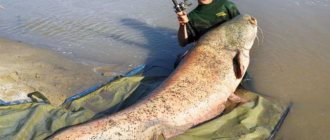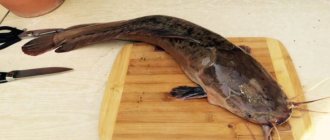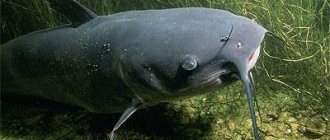Equipment Features
Both dry and wet wetsuits are suitable for spearfishing for catfish Dry suits consist of a layer of thermal insulation and a waterproof layer, they retain heat better. Wetsuits are made of porous rubber fabric (neoprene) made up of many small bubbles filled with nitrogen. Water in small quantities gets under the fabric of the wetsuit and is heated by body temperature. It is best to match suits to the color of aquatic vegetation, this makes it easier to get close to the object being tracked. The choice of dry or wet suit depends on the time of year the hunt will take place and the water temperature. You will also need fins with a closed heel (so that the straps for attaching the fins do not cling to aquatic vegetation), a breathing tube and a mask.
An auxiliary item for hunting will be a flashlight with a good light source. The catfish is a nocturnal predator; during the day it mainly rests. With a flashlight, it is easier to find fish at depth in places where they lie, and to detect them at night when moving.
Equipment selection
Speargun
Each specialized store offers a large assortment of underwater guns, adapted for specific hunting conditions. When choosing such a tool, it is important to understand that there is no universal gun.
To catch catfish, it is more advisable to purchase a powerful tool with a sufficiently high killing power and a fast arrow speed. This is, of course, a weighty product, but going at such a gigantic opponent with bare hands is dangerous not only for health, but also for life. Mid-class shotguns are more suitable for catching peaceful fish; they are distinguished by their low weight and low power.
A speargun must be:
- Comfortable , does not fall to the side, does not cause pain in the palm.
- With good performance characteristics.
- With enough weight.
- The color of the instrument must completely match the camouflage suit, otherwise the predator will simply leave.
Flashlight
For supporters of night fishing, you will need a durable and high-quality lighting device. The brightness control system is of great importance here. In search of an object of fishing, the underwater accessory must clearly illuminate the water column, and when prey is detected, switch to the desired mode in a timely manner, without failures in operation. Another important nuance: the underwater lighting accessory must have buoyancy.
The underwater light should be:
- Waterproof , withstand depth more than 30m.
- Simple and easy to use.
- Compact and not heavy.
- With a sufficient spot size of the illuminated area.
- With a long charge , battery-powered models have proven themselves well.
Wetsuit
It all depends on the season of use, personal preferences and financial capabilities of the fisherman. For the warm season, suits of medium modularity are suitable, where there is no need to be heavily insulated. But for autumn and winter you will need high-quality thermal underwear and a thick suit.
Here you can choose either a suit that fits over your head or a model with a waterproof zipper.
As for the color of camouflage, for the summer it is better to give preference to gray and white colors (they absorb ultraviolet rays well), and in winter to use black equipment. A wetsuit that imitates the appearance of aquatic vegetation is suitable as a successful camouflage option.
You need to choose a suit in strict accordance with the size in order to avoid chafing in the legs and armpits. Pay attention to the quality and composition of the product, the camouflage aspect.
Choosing a weapon for catfish hunting
To hunt catfish, you need a weapon with great destructive power, short, durable, and comfortable in the hand. These parameters are fulfilled by pneumatic underwater weapons. It is best that the handle and trigger are located at its end part. Then it is easier to aim at an outstretched arm and get closer to the target. Air gun harpoons are not notched, they are strong and difficult to break. The diameter of the harpoon should be from 8 mm. Rubber band guns probably won't work. They have weaker killing power, a thin and light harpoon with notches that can easily break when hitting a large target.
Article on the topic: Catching catfish with kwok
The best time of year for hunting
The most successful time of year for any underwater hunting, including catfish, is early spring or late autumn, when the water in fresh reservoirs is as clear as possible.
Many people believe that there is no point in spearfishing in fresh water in the summer. However, this is a myth. Even in summer, visibility in fresh water is a meter or two, and this is usually enough for successful hunting. But there are much more fish in summer. True, it moves, and it is more difficult to hit it.
Best time to hunt
In spring, catfish begin to spawn. During this period, hunting for predators is prohibited. It is allowed to catch this fish after the ban is lifted.
In summer, hunting is much more enjoyable, but finding prey becomes difficult. Aquatic vegetation interferes, visibility decreases, and the water is less clear.
The optimal time for underwater hunting for catfish is autumn, from the end of August until the beginning of cold weather. At this time, hunting is most productive. Visibility in the water is much better than in summer (the water is clearer). The amount of aquatic vegetation decreases.
In winter, with the onset of cold weather, the fish go deeper into wintering pits, become inactive, and fall into suspended animation. Shooting a sleepy fish will not bring pleasure to a real hunter.
Some safety tips
Useful recommendations for beginner underwater hunters:

You can only hunt if you are in good physical shape; weakness or malaise is a serious reason to refuse spearfishing.- Before diving, it is mandatory to check the weapon and equipment (condition of the line, operation of the reel, attachment of the knife, and so on).
- One dive requires one shot and no more, otherwise excitement will lead to the situation under water getting out of control.
- When fighting a strong opponent, you cannot force events: pull him up with force, wind a line around your hand, grab an arrow, and so on.
- It is advisable to hunt together with a partner who will help in difficult times.
Underwater hunting for catfish will be productive and interesting if you follow all safety rules in the water. Video on the topic:
Underwater Hunting for Catfish. Habitats and Search Tactics...CONFIRMER
13:58
Underwater Hunting. Catfish 110 kg… Spearfishing Catfish 110 kg.
05:11
Spearfishing for catfish - 2
10:48
Spearfishing 2021 "NORA". A GIANT catfish weighing 89 kg TIED A HARPOON IN A KNOT. Super trophy.
09:26
narybalke
How to defeat a wounded catfish?
Once the target has been identified, it is necessary to fire the shot correctly and accurately. You can shoot at any place, but try not to hit the belly of the fish. There are no bones on the belly; the harpoon will only catch on soft tissue. With such a hit, the escape of the fish is guaranteed. It is preferable to shoot at the ridge, its central part. You can also hit the predator in the tail. This place is thinner, and the harpoon will go right through, which will allow it to fix on the skin on the opposite side. A headshot would also be an excellent option, provided the weapon has good stopping power. No matter what part of the fish’s body the shot is fired at, you should not pull the line sharply. If possible, you should swim after the fish for some time, after which you should thoroughly exhaust the future prey by pulling and releasing the line. You should not completely release the rope; you need to keep it under constant moderate tension. Having sufficiently exhausted the opponent, the prey is put on the kukan. You cannot bring a strongly resisting fish close to you, so as not to get injured. Also, you don’t need to grab the harpoon right away. The victim will feel the fulcrum and may step off or injure the fisherman.
Minimum Required
What does a hunter need to catch a catfish?
Weapon. Specialized stores offer a wide range of guns for underwater hunting, but you must understand that there is no universal underwater weapon. To catch a mustachioed predator you will need a powerful but short tool, convenient for working in cramped conditions. It should give the harpoon a high initial speed and have good stopping power. Going after the owner of a pond with a low-power, middle-class gun is the same as trying to catch him with your bare hands. Harpoons should be at least 8 mm in diameter, hardened to 40 units (HRC) on the Rockwell scale. If you hit a 20-kilogram catfish with a “raw” harpoon, it will simply bend, and the frightened fish will disappear into the darkness of the depths.
Features of hunting for catfish in various bodies of water
The habits of catfish living in large rivers with strong currents differ from the habits of predators in small bodies of water. In deep rivers with strong currents there are no blockages, snags or dense vegetation, so catfish in them rest on the bottom, near riffles, on uneven terrain, and are found near large underwater rocks and boulders. When hunting in large rivers, you need to be more careful about your equipment. After all, you will have to hunt in strong currents (where whirlpools are possible) and at great depths. In lakes and reservoirs, predators live at the bottom in dense bottom thickets, near the shores, in thickets of reeds and reeds, under floating bodies formed by branches, grass, drifting debris (boards, twigs, bark), and roots of aquatic plants. Hunting in such conditions will require endurance and determination. It will not be easy to wade through the dense water growth and identify the prey.
Article on the topic: Do-it-yourself quack for catfish
Where to look for fish
Catfish is a bottom-dwelling fish that loves deep and calm sections of rivers with holes and pools. During the day you need to look for it in the most shaded places.
Coastal depressions
Before diving, you can look for an area with steep, washed-out banks : in such places there is a high probability of finding good fish. Catfish live in niches that form in the steep underwater walls of the banks, so it’s worth a look there.
Rubble and snags
Catfish also like to spend their days in rubble and snags. Having found a bunch of fallen tree trunks at the bottom , you need to properly examine it. If you study the blockage, starting from its front part, the current can simply press it against the trunks or pull it under them.
Therefore, you need to approach the blockage from the top, side or back.
Thickets of egg capsules and water lilies
Another favorite resting place for catfish is in the river. The wide leaves of the plants create twilight , in which the fish stands. It is necessary to dive under the “burdocks”, hover at the surface of the water under a roof of leaves and try to look for catfish in the gaps between the leaves.
Grass thickets in lakes
In lakes and reservoirs, catfish prefer to spend the day in thickets of aquatic vegetation: reeds, reeds, cattails. Old dead stems form roofs on the surface of the water, under which the mustachioed can rest very comfortably. In places where there are no such roofs, catfish simply lie on the bottom among the reeds.
Exploring other areas for catfish
When exploring the bottom in search of a trophy, you must remember to look up. Perhaps in the upper layers of the water you will find a worthy individual that you did not notice during the first inspection. Sometimes catfish can be seen on the open bottom of a reservoir. They also prefer to rest in old beaver burrows, near steep slopes and shores, near coastal cornices and niches. Also, the habitat of catfish can be bypass canals and irrigation canals. There is a lot of vegetation on the banks of such canals. The side banks of such buildings are often protected by concrete slabs. There are cracks, washouts, and holes between the slabs and under them. This is an excellent refuge for a predator.
Where does catfish live?
Catfish live in pits and pools of snags; you can often find catfish in pipes or beaver burrows. If a catfish goes out into shallow water for a daytime stay, it chooses places with abundant aquatic vegetation, mostly these are cluttered places with branches, garbage and all kinds of swimmers, in general, places where the sun’s rays do not reach a kind of aquatic vampire. Always where it is dark, hunting only at night, whatever blood it doesn’t drink, it eats right away. Therefore, to search for catfish, you simply need a flashlight. Be careful when inspecting any kind of holes or abandoned pipes, as the catfish often attacks first and can easily knock you out, and knocking you out underwater can cost you dearly.
Catfish lifestyle
The catfish is a predatory fish with a naked body and a barbel on each jaw. He builds nests, guards eggs and takes care of his offspring.
There are four types of catfish in our country:
- The common catfish is a commercial fish and lives mainly in the rivers of the Black Sea and Aral-Caspian basins;
- Amur catfish - in the Amur River, in the rivers of Primorye, on Lake Khanka, Baikal, Gusinoye;
- Soldatov's catfish is found on Lake Khanka, in the Ussuri and Amur rivers;
- channel catfish are bred artificially in ponds in the Kuban basin, in the Ural reservoirs, and in pond farms in the Moscow region.
These predators are night hunters. During the day they rest, and at night they go out hunting and eat everything that moves: fish, crayfish, frogs, waterfowl, muskrats and even turtles.
In order to catch its prey, the catfish sits in ambush for a long time, then suddenly rushes at the prey and swallows it with its huge mouth. Rarely does anyone manage to slip past a predator.











